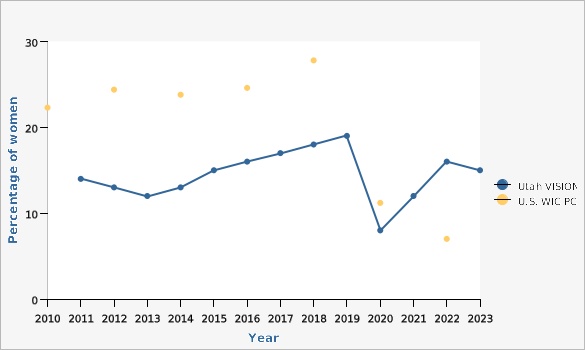Complete Health Indicator Report of Low hemoglobin levels in women enrolled in the Utah WIC program
Definition
Definitions used in this Indicator Report follow the current United States Department of Agriculture (USDA), Women, Infants, and Children (WIC) program definitions which are as follows: '''Low hemoglobin levels''': Hemoglobin concentration below the 95 percent confidence interval (i.e. below the .025 percentile) for healthy, well-nourished individuals of the same age, sex, and stage of pregnancy.Numerator
__2010-Current:__ The number of pregnant, breastfeeding, and postpartum women receiving WIC services who had '''low hemoglobin levels''' (see definition).Denominator
__2010-Current:__ The number of pregnant, breastfeeding, and postpartum women receiving WIC services.Data Interpretation Issues
Beginning in 2010, national data are from USDA's WIC Program and Participant Characteristic Survey. This survey is released every 2 years. Utah data, beginning in 2011, are from the WIC computer system VISION, created by Ciber. From 2020-2022, FNS provided waivers for all WIC clinics to defer the collection of hemoglobin levels due to the COVID-19 pandemic. This made it difficult to collect accurate data during this time. This may have contributed to the fluctuation in low hemoglobin prevalence during these years.Why Is This Important?
Hemoglobin is an iron-rich protein in red blood cells that carries oxygen throughout the body. A low hemoglobin level may mean you have iron-deficiency anemia. Iron-deficiency anemia happens when there are low amounts of red blood cells in your body. It can be caused by blood loss, iron deficiency, kidney failure, or cancer. Iron deficiency is the most common cause of iron-deficiency anemia. Iron-deficiency anemia is more common among women compared to men, and most common during pregnancy. Mild to moderate iron-deficiency anemia may go unnoticed if the person doesn't have common signs or symptoms. Common signs and symptoms of iron-deficiency anemia include fatigue, shortness of breath, pale skin, or chest pain. Complications of iron-deficiency anemia may include heart problems, increased susceptibility to illness and infections, and a higher risk of complications such as preterm birth or low birth weight if left untreated.How Are We Doing?
Rates of anemia have been steadily increasing nationwide among the WIC population for several years. African American women are more likely to experience iron deficiency and low hemoglobin levels than other races or ethnicities.How Do We Compare With the U.S.?
The percentage of pregnant, breastfeeding, and postpartum women enrolled in the Utah WIC program with low hemoglobin levels (hemoglobin levels below a normal range) was 15% in 2023. This is a 21% decrease in the number of women enrolled in WIC with low hemoglobin levels since 2019. This follows the national trend of a decrease in the number of women enrolled in WIC programs with low hemoglobin levels. The rapid decrease in the percentage of WIC-enrolled women with low hemoglobin levels nationwide is likely due to the 2020-2022 waivers issued by FNS related to the COVID-19 pandemic. These waivers allowed WIC clinics to defer the collection of hemoglobin levels. This also likely contributes to the rapid decrease in percentage in Utah in 2020, and increased percentages in recent years as hemoglobin levels are being checked regularly again.What Is Being Done?
The Utah WIC program provides nutrition education to all WIC participants. Participants with low hemoglobin levels receive education on what low hemoglobin levels mean, why hemoglobin and iron are important, and ways to increase iron levels. Iron-deficiency anemia is primarily treated by increased oral intake of iron. Iron supplements or iron-rich foods (foods that have a lot of iron in them) are the best sources of iron. Talk to a healthcare provider if you have iron-deficiency anemia. Some ways to increase your iron levels: *Eat iron-rich foods such as meat, chicken, dark leafy green vegetables, and beans. *Eat foods that have a lot of vitamin C in them such as fruits, vegetables, and 100% fruit juice. Vitamin C helps your body absorb iron better. *Eat or drink dairy products at a different time of day than when you take an iron supplement or eat iron-rich foods. This will help you absorb iron better. *Talk with your doctor about taking an iron supplement or multivitamin that has iron in it.Health Program Information
Utah WIC Program: 1-877-WIC-KIDS [http://wic.utah.gov]Graphical Data Views
Percentage of women who are pregnant, breastfeeding, or postpartum and enrolled in the Utah WIC program with low hemoglobin levels, Utah vs. U.S., 2010-2023

| Utah vs. U.S. WIC | Year | Percentage of women | ||||
|---|---|---|---|---|---|---|
Record Count: 20 | ||||||
| Utah VISION | 2011 | 14.0% | ||||
| Utah VISION | 2012 | 13.0% | ||||
| Utah VISION | 2013 | 12.0% | ||||
| Utah VISION | 2014 | 13.0% | ||||
| Utah VISION | 2015 | 15.0% | ||||
| Utah VISION | 2016 | 16.0% | ||||
| Utah VISION | 2017 | 17.0% | ||||
| Utah VISION | 2018 | 18.0% | ||||
| Utah VISION | 2019 | 19.0% | ||||
| Utah VISION | 2020 | 8.0% | ||||
| Utah VISION | 2021 | 12.0% | ||||
| Utah VISION | 2022 | 16.0% | ||||
| Utah VISION | 2023 | 15.0% | ||||
| U.S. WIC PC | 2010 | 22.3% | ||||
| U.S. WIC PC | 2012 | 24.4% | ||||
| U.S. WIC PC | 2014 | 23.8% | ||||
| U.S. WIC PC | 2016 | 24.6% | ||||
| U.S. WIC PC | 2018 | 27.8% | ||||
| U.S. WIC PC | 2020 | 11.2% | ||||
| U.S. WIC PC | 2022 | 7.0% | ||||
Data Sources
- VISION computer system, Utah Women, Infants and Children (WIC) Program, Office of Maternal and Child Health, Utah Department of Health and Human Services
- WIC PC - WIC Participant and Program Characteristics, U.S. Department of Agriculture, Food and Nutrition Service
More Resources and Links
Evidence-based community health improvement ideas and interventions may be found at the following sites:- Centers for Disease Control and Prevention (CDC) WONDER Database, a system for disseminating public health data and information.
- United States Census Bureau data dashboard.
- Utah healthy Places Index, evidence-based and peer-reviewed tool, supports efforts to prioritize equitable community investments, develop critical programs and policies across the state, and much more.
- County Health Rankings
- Kaiser Family Foundation's StateHealthFacts.org
- Medical literature can be queried at PubMed library.
Page Content Updated On 01/16/2024,
Published on 02/26/2024
